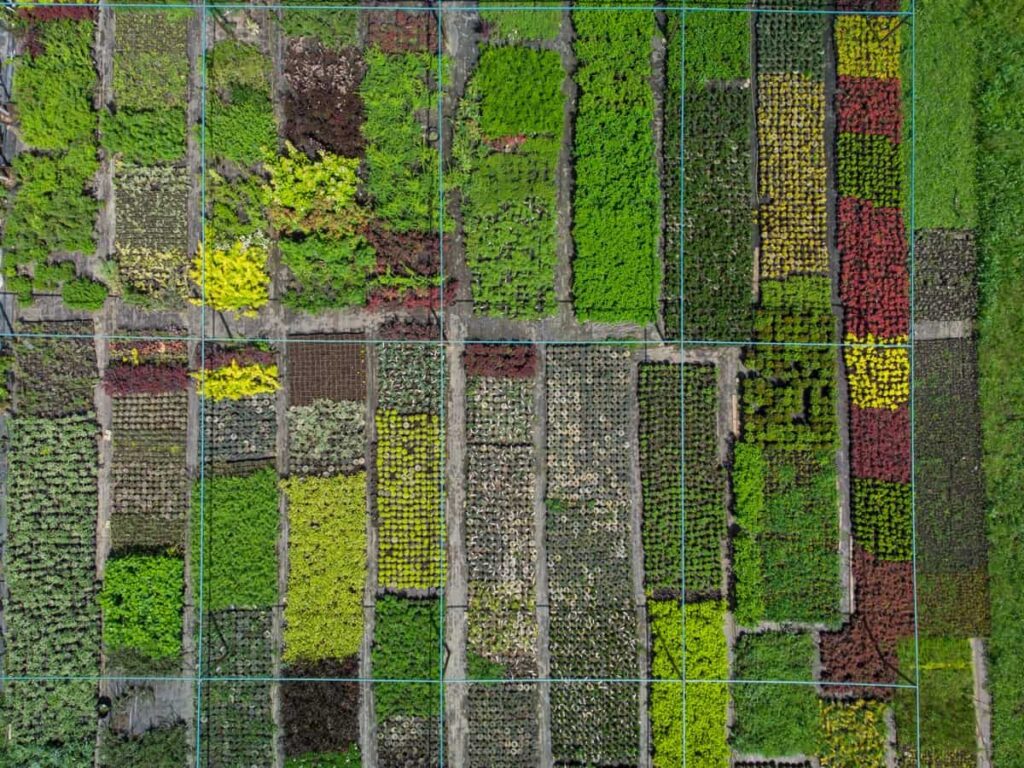Mixed farming is a method of agricultural production that involves cultivating crops and raising livestock on the same farm. The practice is becoming increasingly popular as farmers seek to maximize their land use and diversify their income streams. However, starting and managing a successful mixed farming business requires careful planning and strategic decision-making. A well-crafted business plan is essential for identifying goals, developing strategies for achieving them, and managing resources effectively.

A step-by-step guide to creating a successful mixed farming business plan can help farmers navigate the industry’s complexities and ensure a profitable and sustainable operation. This guide should include an industry overview, market analysis, financial projections, and strategies for managing risks and resources. Farmers can develop a clear vision for their business and succeed in the competitive mixed farming industry by following a step-by-step approach.
Mixed Farming Business Plan
What is Mixed Farming?
Mixed agriculture is a type of farming that involves both the cultivation of crops and the raising of livestock on the same farm. The practice is common in many countries, including India, Malaysia, Indonesia, South Africa, Canada, and Russia. In mixed farming, crops, and livestock are interdependent, with animal waste used as fertilizer for crops and crops used as feed for livestock.
This maximizes land use and creates a sustainable and efficient system. Mixed farming can include a variety of crops and livestock, such as cereal crops, vegetables, fruits, cattle, sheep, pigs, and poultry. This approach allows farmers to diversify their income streams and mitigate risks associated with relying on a single commodity. As agriculture continues to evolve, mixed farming remains a popular and important method of agricultural production.
Need for Mixed Farming
Mixed farming refers to an agricultural system in which farmers perform different agricultural practices together, such as crop cultivation, livestock rearing, horticulture, forestry, and fisheries, on the same farm. In India, where agriculture is the main source of income for most people, mixed farming has become an important way of handling the various problems faced by the different sub-sectors of agriculture. With extreme climate changes and volatile agricultural markets, mono-culture activity could be risky, and farmers who depend solely on the value of a single crop are under threat.
Mixed farming provides better income returns to farm owners and higher productivity. It reduces the cost of production per unit area, increases income and productivity, and reduces the risk to farmers. The mixed farming system could be crop-livestock, crop-forestry, crop-horticulture, fish-pig, fish-duck, paddy-fish, etc. In addition, mixed farming promotes sustainable agriculture by utilizing natural resources efficiently without balancing the environment.
What are the Benefits of Mixed Farming
- Mixed farming is a method of farming that involves growing crops and raising livestock on the same piece of land. This type of farming offers numerous benefits to farmers.
- One of the benefits is that it allows farmers to keep their areas under continuous production, thereby enriching the growth of the farmland. It also raises the per capita profitability of farmers by diversifying their income sources.
- Mixed farming involves the complementary use of crops and livestock. Farmers grow fodder in the field, used to feed the livestock. This improves the land’s health and boosts the harvest return.
- Moreover, it helps farmers earn money throughout the season. When crops fail due to climatic or other reasons, livestock can provide an alternative source of income.
- Keeps the environmental balance by reducing the dependence on chemical fertilizers.
In case you missed it: Beekeeping Business Plan: Bee Farming Cost, Profit, and Project Report in India

Methods of Mixed Farming Systems
- Co-cultivation farming involves growing two or more crops on the same land simultaneously, with each crop benefiting the other. The crops should have different water requirements, maturation times, root depths, and nutrient requirements. Examples include maize and potato, cotton and moong bean, sorghum, and pigeon pea.
- Agricultural crops with garden system: Farmers grow agricultural crops in the fertile wasteland in the fruit crops/garden. For instance, growing spices in a coconut garden.
- Agricultural with forestry system: This system involves growing forestry plants and crops together. In some places, trees are grown around the bunds of a field crop.
- Beekeeping with crops: This system involves cultivating crops along with beekeeping to ensure a steady supply of flowers for bees. Suitable crops include sunflower, mustard, and others.
- Fish with pig farming: This system involves rearing fish with pig farming. About 30-40 pigs provide enough manure to raise fish in one hectare of a pond.
- Farm pond system: In this system, farmers construct small ponds to store rainwater, which can be used for fish farming or growing vegetables.
- Fish with duck farming: This system involves raising fish, ducks, and vegetables together. Approximately 250-300 ducks are enough to manure a 1 ha of water-spread area.
- Fish with paddy farming: Farmers can cultivate paddy and raise fish in this system. This method can increase the yield of paddy by more than 50%.
What is a Business Plan?
A business plan is a formal document that helps in outlines the goals and objectives of a business and the strategies that will be used to achieve them. It provides a roadmap for the organization and helps to guide decision-making, allocate resources, and measure progress.
In case you missed it: Crafting a Regenerative Farming Business Plan for a Thriving Future

How to Start a Mixed Farming Business
- Market research involves gathering information about the demand for your products and the competition in your area.
- Choosing a location: You need to select a location that is suitable for farming and is easily accessible to customers and suppliers.
- Securing funding: You will need to determine the amount of funding you need to start your business and explore financing options such as loans, grants, and crowdfunding.
- Developing a business plan: Your business plan should outline your goals, strategies, and financial projections.
- Obtaining necessary permits and licenses: You must obtain permits and licenses from local and state authorities to operate your business legally.
- Acquiring equipment and supplies: You will need to purchase equipment such as tractors, plows, and harvesters, as well as seeds, fertilizers, and other supplies.
- Hiring employees: You may need employees to assist with farming operations, marketing, and administration.
Why You Need a Mixed Farming Business Plan
- A business plan helps clarify goals and strategies.
- It helps secure funding from investors and lenders.
- A business plan provides a framework for measuring progress.
- It helps communicate with stakeholders such as employees and suppliers.
Sources of Funding for Mixed Farming Business
Funding sources for a mixed farming business include loans from financial institutions and government and private grants for sustainable and organic farming.
Executive Summary for Mixed Farming Business
The summary is the first section of your business plan, providing a brief business overview. It should include the following:
- A description of your mixed farming business and its products.
- An overview of the market and competition.
- Your goals and strategies for achieving them.
- Your financial projections.
- A summary of your team and their qualifications.
In case you missed it: Organic Farming Profits Per Acre in India: Cost of Cultivation, Production Key Rules to Double Returns

Business Overview of Mixed Farming Business
- A mixed farming business combines multiple agricultural practices, such as crop production, animal husbandry, and forestry, within a single farm operation.
- The goal of mixed farming is to diversify income streams and maximize the use of available resources, including land, labor, and equipment.
- Mixed farmers may grow crops like wheat, corn, or soybeans and raise livestock such as cattle, pigs, or chickens.
- They may also engage in other agricultural activities like beekeeping, fish farming, or fruit and vegetable cultivation.
- To succeed, mixed farmers must be knowledgeable about various farming techniques, crop and livestock management, and marketing strategies.
- A successfully mixed farming business requires careful planning and management and the ability to adapt to changing market conditions and weather patterns.
- Mixed farming businesses can provide various benefits, such as sustainable land use practices, local food production, and rural economic development.
Business Analysis of Mixed Farming
- This type of farming provides a diverse source of income and reduces the risks associated with a single crop failure.
- Farmers in mixed farming often use crop rotation to maintain soil fertility and reduce the spread of diseases.
- Livestock raised in mixed farming can provide additional income by selling meat, dairy, and other animal products.
- Mixed farming requires significant investment in infrastructure and equipment, including buildings, machinery, and storage facilities.
Business Opportunity in Mixed Farming
- Mixed farming offers a range of business opportunities, including cultivating multiple crops and raising different types of livestock, which can be sold to local or regional markets.
- Farmers can also sell their products online or through farmer’s markets, which are becoming increasingly popular.
- Value-added products, such as cheese, yogurt, and other dairy products, can be made from milk produced by livestock, which can be sold at a higher price than raw milk.
- Using sustainable and organic farming practices, mixed farmers can tap into the growing organic and environmentally friendly products market.
- Mixed farming can also provide opportunities for agritourism, such as farm stays, tours, and other on-farm activities, which can provide an additional source of income.
- Mixed farming can provide opportunities for collaboration with other farmers and businesses, such as cooperatives and joint ventures, to share resources and reduce costs.
In case you missed it: How to Start Polyhouse Farming from Scratch: For Vegetables, Flowers, and Herbs

Marketing Plan for Mixed Farming
- Identify your target market: Determine the audience for your mixed farming products, such as local consumers, restaurants, or specialty markets.
- Develop a unique selling proposition: Define what sets your products apart from competitors, such as using sustainable farming practices or producing value-added products.
- Build brand awareness: Develop a brand that resonates with your target market, a logo, and a website that highlights your products and values.
- Leverage social media: Use social media platforms like Facebook, Instagram, and Twitter to showcase your products and engage with customers.
- Offer promotions and discounts: Provide incentives to encourage repeat business, such as discounts on bulk purchases or loyalty programs.
Business Operation of Mixed Farming
- Crop and livestock planning: Determine which crops and livestock to cultivate and raise, and develop a planting and harvesting schedule to maximize yield.
- Land and equipment management: Ensure all equipment is properly maintained and serviced and the land is prepared for planting and grazing.
- Animal care and health: Provide proper nutrition, healthcare, and shelter for all livestock, and monitor their health regularly to prevent diseases.
- Sales and marketing: Develop a sales and marketing strategy to sell the crops and livestock, such as through local markets, online platforms, and partnerships with other businesses.
- Financial management: Keep accurate records of expenses and revenue, and create a budget to ensure the business remains profitable. Regularly analyze financial statements and make adjustments to improve profitability.
In case you missed it: Earning 10 Lakh From Lemongrass Farming: How This Farmer Turned Rich by Growing This Medicinal Plant

Mixed Farming Business Management
Mixed farming business management involves overseeing all aspects of the farming operation, from crop and livestock production to sales and marketing, financial management, and human resources. Effective management requires a strong understanding of agriculture and business management principles such as budgeting, strategic planning, and risk management.
To remain competitive, farmers must stay current with changing regulations, industry trends, and emerging technologies. Communication and leadership skills are also important, as farmers must effectively communicate with employees, partners, and customers to ensure the business’s success.
Financial Plan for Mixed Farming Business
A financial plan for a mixed farming business should include a budget, revenue forecast, and strategies for managing expenses and generating income. The budget should account for all expenses, including equipment, labor, feed, maintenance, and projected crop and livestock sales revenue.
Strategies for managing expenses include using sustainable farming practices to reduce costs, negotiating prices with suppliers, and investing in renewable energy sources to lower costs. Income can be generated by diversifying products, offering value-added products, and collaborating with other businesses. Farmers should also consider financing options such as grants, loans, and crowdfunding to ensure adequate capital for the operation. Regular financial monitoring and analysis can help identify areas for improvement and opportunities for growth.
Conclusion
A well-crafted mixed farming business plan is essential for anyone looking to start a mixed farming business. It serves as a roadmap to success and helps secure funding, attract investors, and identify potential challenges and opportunities. By following the step-by-step guide outlined in this article, farmers can create a comprehensive business plan tailored to their specific needs and goals, setting them on the path to a successful and profitable farming operation.
- Management Pests and Diseases in Your Cotton Field
- Sheep Farming Business Plan for Beginners
- Aquaponic Farming at Home: A Step-By-Step Guide
- Profitable Village Farming Business Ideas in 2024
- High-Yield Aquaculture: Fast-Growing Fish for Farming
- Effective Fish Pond Construction Techniques for Beginners
- Irrigation and Water Management in Pineapple Farming
- Blossom to Harvest: Mastering Flowering and Pollination in Papaya Farming
- Pig Fattening Essentials: From Selection to Sale for Beginners
- Raising Wagyu Cattle: A Complete Guide for Premium Beef Production
- Soil Types and Their Water Holding Capacity
- Optimizing Irrigation Schedules for Coconut Groves for Enhanced Yield
- Espresso Your Garden: Coffee Grounds for Healthier Acid-Loving Plants
- The Best Soil Mix for Snake Plants: How to Mix Your Own Snake Plant Soil
- Green Thumb Success: Expert Tips for Cultivating Greenhouse Beans All Year Round
- Bloom All Year Round: The Ultimate Guide to Indoor Hyacinth Care
- Eco-Friendly Gardening: How to Make Liquid Fertilizer from Kitchen Waste
- Ultimate Guide to Grow Anise in Pots: Explore Seed Propagation to Harvesting
- Guide to Raising Chester White Pigs: Discover Breed Facts to Growth Management
- Mastering the Elegance: The Ultimate Guide to Weeping Cherry Tree Care, Planting, and Maintenance
- Ultimate Guide to Planting Garlic in Grow Bags: Growing Strategies for Beginners
- How to Fix Spider Plant Leaf-Related Problems: Natural and Organic Remedies
- 10 Reasons Why Your Tulsi Plant is Shedding Leaves: Home Remedies and Solutions
- Optimizing Growth and Yield: The Advantages of Palm Bunch Ash Fertilizer
- Utilizing Neem Oil Extract as a Natural Pesticide for Hydrangea
- From Soil to Harvest: Various Ways in Which Farmers Can Use AI Tools
- Steps to Encourage and Induce Citrus Flowers: A Comprehensive Guide
- How to Fix Snake Plant Leaf-Related Issues: Natural and Organic Remedies
- Transform Your Garden into a Fragrant Oasis with Raat Ki Rani (Night Blooming Jasmine)
- Discover the Ideal Chicken Breeds for Philippine Farms
- How to Create a Poultry Egg Farm Business Plan for Profits
- Grow Lemon Cucumbers Like a Pro: Insider Techniques for Bountiful Yields
- Ultimate Guide to Caring for Your Pink Princess Philodendron: Tips for Thriving Variegation
- Areca Nut Profit Per Acre: Calculating Yield and Cost of Cultivation
- How Kaveri Chicken is Becoming a More Profitable Breed in Indian Backyards
- Transform Your Barn: 9 Steps to Convert a Horse Stall into a Chicken Coop
